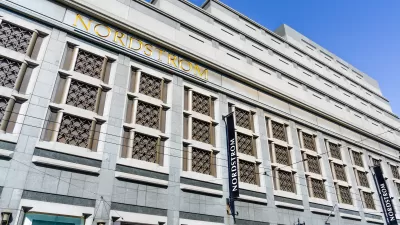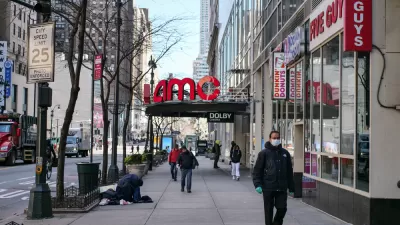The pandemic is accelerating recent trends in commercial real estate with potentially catastrophic consequences for the commercial corridors that play such a fundamental role in the urban fabric.

An article by Jorge González and Jein Park checks in with the state of commercial corridors, which the article calls the "backbone of neighborhoods."
Despite their centrality to so many neighborhoods commercial corridors are dealing with major destabilizing forces, and according to the article that destabilization reaches far beyond the businesses owners effected by the economic effects of the pandemic. " Increased storefront vacancies not only indicate economic hardship for property owners, businesses, and local governments (through reduced fiscal revenues), but they also affect the surrounding communities," write González and Park.
The article identifies one critical trend: The pandemic is accelerating a decade-long trend of rising retail vacancies.
Today, Yelp data show permanent business closures have increased steadily since the pandemic began, and as of September, 60 percent of the 160,000 closures registered in the platform were permanent. The hardest-hit businesses are restaurants, retail stores, beauty stores and spas, bars and nightlife venues, and fitness venues—key components of commercial corridors.
The negative effects of vacancies (e.g., reduce property values, fire risk, crime, and negative health effects) can be mitigated by local governments, according to the article, even if the federal government never puts together a second round of economic stimulus. Among the suggested prescriptions for the economic downturn for commercial corridors during the pandemic, the article suggests grants and loans, repurposing of public spaces previously devoted to automobiles, relaxed zoning and permitting, and public art programs, vacancy taxes, and more.
Each recommendation includes more detail in the source article.
FULL STORY: Local Policies Can Protect Commercial Corridors as the Pandemic Continues

Maui's Vacation Rental Debate Turns Ugly
Verbal attacks, misinformation campaigns and fistfights plague a high-stakes debate to convert thousands of vacation rentals into long-term housing.

Planetizen Federal Action Tracker
A weekly monitor of how Trump’s orders and actions are impacting planners and planning in America.

In Urban Planning, AI Prompting Could be the New Design Thinking
Creativity has long been key to great urban design. What if we see AI as our new creative partner?

King County Supportive Housing Program Offers Hope for Unhoused Residents
The county is taking a ‘Housing First’ approach that prioritizes getting people into housing, then offering wraparound supportive services.

Researchers Use AI to Get Clearer Picture of US Housing
Analysts are using artificial intelligence to supercharge their research by allowing them to comb through data faster. Though these AI tools can be error prone, they save time and housing researchers are optimistic about the future.

Making Shared Micromobility More Inclusive
Cities and shared mobility system operators can do more to include people with disabilities in planning and operations, per a new report.
Urban Design for Planners 1: Software Tools
This six-course series explores essential urban design concepts using open source software and equips planners with the tools they need to participate fully in the urban design process.
Planning for Universal Design
Learn the tools for implementing Universal Design in planning regulations.
planning NEXT
Appalachian Highlands Housing Partners
Mpact (founded as Rail~Volution)
City of Camden Redevelopment Agency
City of Astoria
City of Portland
City of Laramie





























